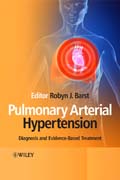
Pulmonary arterial hypertension: diagnosis and evidence-based treatment
Barst, Robyn
INDICE: Preface Contributors 1 Introduction Robyn J. Barst 2 Diagnosis and assessment of pulmonary arterial hypertension Michael D. McGoon, Adam Torbickiand Ronald J. Oudiz 2.1 Hemodynamics of pulmonary hypertension 2.2 Venice classification 2.3 Overview of the diagnostic process (algorithm) 2.4 Screening (identifying a pre-existing risk) 2.5 Detection (discovering pulmonary hypertension) 2.6 Definition (diagnosing the clinical context) 2.7 Prediction (estimating prognosis) 2.8 Principles of follow-up (evaluating and responding to outcome) 2.9 Specific tests in the evaluation of pulmonary hypertension 3 Conventional therapy in pulmonary arterial hypertension Richard N. Channick 3.1 Calciumchannel antagonists 3.2 Diuretics 3.3 Warfarin 3.4 Supplemental oxygen 3.5 Inotropic therapy 3.6 General measures 3.7 Conclusions 4 Prostanoid treatment for pulmonary arterial hypertension Olivier Sitbon and Gérald Simonneau 4.1 Epoprostenol 4.2 Treprostinil 4.3 Iloprost 4.4 Beraprost 4.5 Treatment selection 4.6 Conclusions 5 Endothelin receptor antagonists in pulmonary arterial hypertension David B. Badesch and Marc Humbert 5.1 Bosentan 5.2 Sitaxsentan 5.3 Ambrisentan 5.4 Safety and tolerability with endothelin receptor antagonists 5.5 Conclusions 6 Phosphodiesterase-5 inhibitors in pulmonary arterial hypertension Hossein A. Ghofrani, Werner Seeger and Friedrich Grimminger 6.1 The origins ofphosphodiesterase-5 inhibitor development 6.2 Pulmonary hypertension as a newindication for phosphodiesterase-5 inhibitor treatment 6.3 Role of phosphodiesterase-5 in the pulmonary vasculature 6.4 Clinical experience with sildenafilfor the treatment of chronic pulmonary hypertension 6.5 Pivotal trial and approval of sildenafil for the treatment of pulmonary arterial hypertension (SUPER-1 study) 6.6 Other phosphodiesterase-5 inhibitors 6.7 Combination therapy 6.8 Potential new indications for phosphodiesterase-5 inhibitors outside pulmonary arterial hypertension 6.9 Conclusions 7 Combination therapy for pulmonary arterial hypertension Anne Keogh and Marius Hoeper 7.1 Background 7.2 Combination therapy to date 7.3 Conclusions 8 Interventional and surgical modalities oftreatment for pulmonary arterial hypertension Julio Sandoval and Ramona Doyle8.1 Introduction 8.2 Atrial septostomy 8.3 Pulmonary endarterectomy in chronic thromboembolic pulmonary hypertension 8.4 Lung transplantation for pulmonaryhypertension 8.5 Conclusions 9 End points and clinical trial design in pulmonary arterial hypertension: Clinical and regulatory perspectives Andrew J. Peacock 9.1 Introduction 9.2 Trial design 9.3 End points in trials of therapy for pulmonary arterial hypertension 9.4 Conclusions 10 Comparative analysis of clinical trials and evidence-based treatment algorithm for pulmonary arterial hypertension Nazzareno Galiè, Alessandra Manes, Naushad Hirani and Robert Naeije 10.1 Introduction 10.2 Randomized controlled studies 10.3 Long-term continuation studies 10.4 Combination studies 10.5 Evidence-based treatment algorithm 10.6 Conclusions 11 Diagnosis and assessment of non-pulmonary arterial hypertension masquerading as idiopathic pulmonary arterial hypertension: Diastolic heart failure - evaluation and interactions Mardi Gomberg-Maitland and Stuart Rich11.1 Definition of heart failure 11.2 Epidemiology 11.3 Physiology 11.4 Evaluation of diastolic heart failure: Invasive and noninvasive techniques 11.5 Diagnosis and treatment of diastolic dysfunction 11.6 Pulmonary hypertension and diastolic dysfunction 11.7 Conclusions 12 Treatment of pulmonary arterial hypertension: A look to the future Lewis J. Rubin 12.1 Therapy of pulmonary arterial hypertension 12.2 Measuring outcomes and monitoring the course of therapy 12.3 Conclusions Index
- ISBN: 978-0-470-05972-2
- Editorial: John Wiley & Sons
- Encuadernacion: Cartoné
- Páginas: 272
- Fecha Publicación: 23/05/2008
- Nº Volúmenes: 1
- Idioma: Inglés
